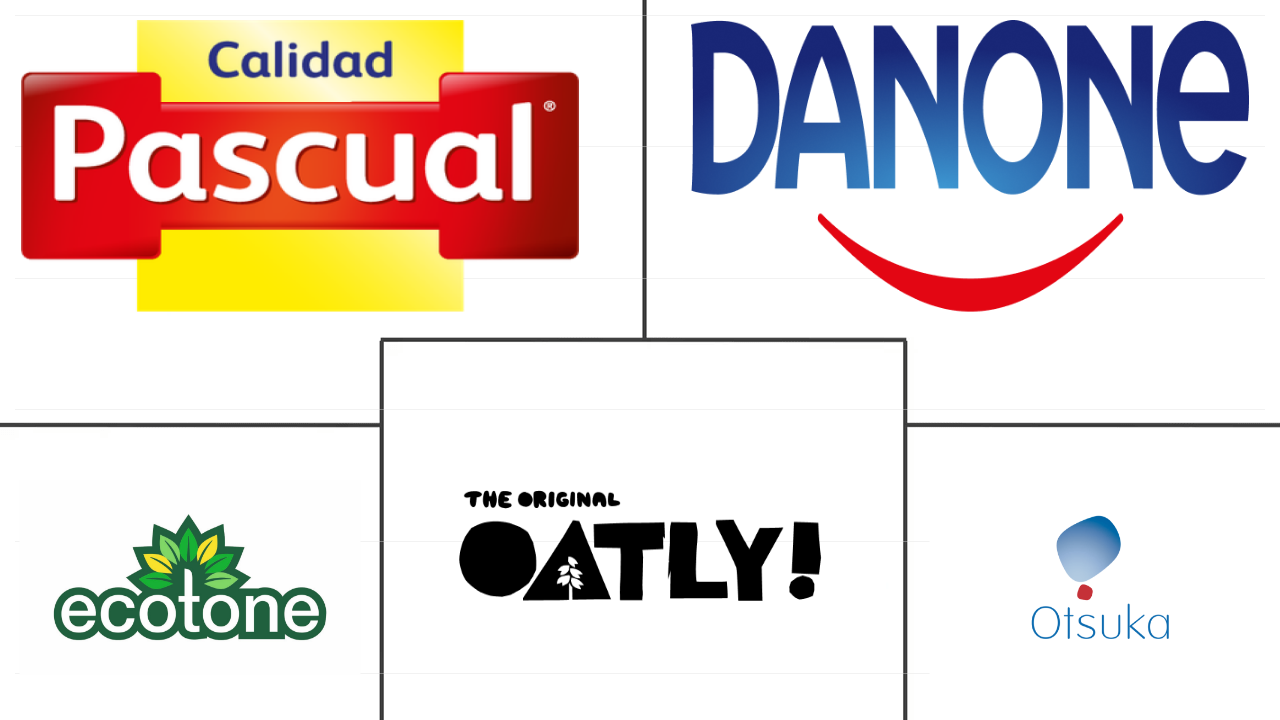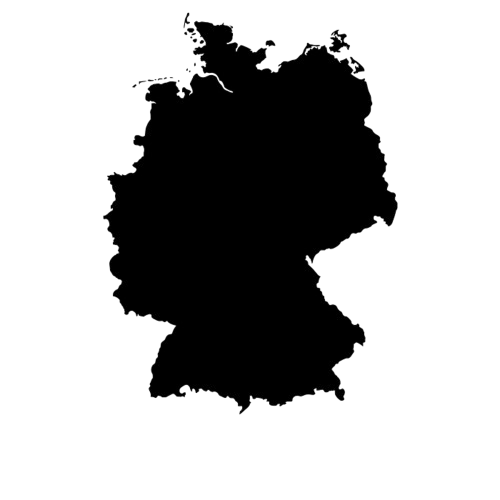Market Size of europe non-dairy milk Industry
|
|
Study Period | 2017 - 2029 |
|
|
Market Size (2024) | USD 5.6 Billion |
|
|
Market Size (2029) | USD 10.96 Billion |
|
|
Largest Share by Distribution Channel | Off-Trade |
|
|
CAGR (2024 - 2029) | 14.38 % |
|
|
Largest Share by Country | Germany |
Major Players |
||

|
||
|
*Disclaimer: Major Players sorted in no particular order |
Europe Non-Dairy Milk Market Analysis
The Europe Non-Dairy Milk Market size is estimated at 5.6 billion USD in 2024, and is expected to reach 10.96 billion USD by 2029, growing at a CAGR of 14.38% during the forecast period (2024-2029).
5.6 Billion
Market Size in 2024 (USD)
10.96 Billion
Market Size in 2029 (USD)
14.55 %
CAGR (2017-2023)
14.38 %
CAGR (2024-2029)
Largest Market by Distribution Channel
97.79 %
value share, Off-Trade, 2023
The wider availability of various brands, ease of reading product labels, and convenience in comparing different products make it the preferred type among dairy consumers.
Largest Market by Country
22.80 %
value share, Germany, 2023

The increasing vegan population in the country with the wider acceptance of innovation in the sector including plant-based milk products is influencing the growth of the segment in the market.
Fastest-growing Market by Distribution Channel
14.44 %
Projected CAGR, Off-Trade, 2024-2029
The increased adoption of e-commerce platforms among the consumers and growing presence of online retailers in the Europe region are anticipated to drive the off-trade segment.
Fastest-growing Market by Country
23.53 %
Projected CAGR, Russia, 2024-2029
In Russia, plant-based milk consumption is the segment that is driven by the rise in a number of individuals who are intolerant to lactose and its' increased health-beneficial factors.
Leading Market Player
25.05 %
market share, Danone SA, 2022

Danone's major focus on the quality and high standards of the products in the plant-based beverages segment with products in a wider range of brands made it the market leader
Easy availability of plant-based milk through wide retail sector is boosting the growth
- Plant-based milk is the innovation leader in the milk category, supported by key advancements in ingredient diversification and product development that seek to replicate the sensory experience and nutritional value of cow’s milk. The sales value of plant-based milk through the overall distribution channel is anticipated to grow by 70.3% in 2026 from 2022.
- Among overall distribution channels, the off-trade segment dominates the distribution channels of the Europe plant-based milk market. Hypermarkets and supermarkets primarily drive the high market share of off-trade channels. The sales value of plant-based milk in supermarkets and hypermarkets registered a growth of 72.57% from 2018 to 2022. These retail channels have a strong position due to the wide selection of brands offered, considerable shelf space, and frequent price promotions.
- Compared to other plant-based milk, soy milk is the most consumed through off-trade channels, with a market share of 38.17% in 2022.
- The region does not have a considerable market for the on-trade channels and is at a nascent stage. Consumers prefer plant-based milk at home and are less likely to drink from a restaurant or food service outlet. On-trade channels acquired less than 3% of the value share in 2022 compared to off-trade channels.
- In Europe, plant-based milk alternatives have been gaining popularity compared to other plant-based products, such as cheese and meat, and many consumers are already familiar with milk alternatives like soy, oat, almond, and coconut milk. In Germany, 93% of consumers already buy plant-based milk alternatives, which is higher than in any other plant-based product category.
Germany plays a major role in the consumption of plant-based milk in the region
- The plant-based milk in the Europe region witnessed a growth of 14.1% in 2022 compared to the previous year, 2021. The growth is attributed to many consumers drawn toward the health and sustainability benefits of plant-based products. Plant-based beverages also claim other advantages, as they have a longer shelf life than dairy-based milk. Cow’s milk usually lasts four to seven days, but plant-based milk lasts up to 10 days at room temperature.
- By country, Germany is the leading market for plant-based milk in the region, and it is anticipated to grow by 77.6% in 2024 compared to the year 2021. Compared to other plant-based products, many consumers in the country are familiar with milk alternatives. Milk is the most preferred plant-based product in the country, with 93% of consumers buying it already. In 2021, 75% of consumers in Germany consumed oat milk as their go-to alternative to conventional milk, 69.4% consumed almond milk, and almost 51% consumed soy milk. Milk is the most preferred plant-based product in the country, with a consumption rate of 93%.
- Spain is the second-leading market for plant-based milk in the region. In Spain, the number of vegans is growing, and more than half of the population wants to reduce meat consumption, considering themselves flexitarian. As of 2022, 30% of Spanish consumers identify as flexitarian, while 6% follow a plant-based diet. The total sales value of plant-based milk in Spain reported an increase from USD 650.7 million in 2021 to USD 706.4 million in 2022, which represented an increase of approximately 8.6%. Compared to other plant-based milk, soy milk is majorly consumed in Spain. In 2022, soy milk accounted for 31.5% of the value share.
Europe Non-Dairy Milk Industry Segmentation
Almond Milk, Cashew Milk, Coconut Milk, Hazelnut Milk, Hemp Milk, Oat Milk, Soy Milk are covered as segments by Product Type. Off-Trade, On-Trade are covered as segments by Distribution Channel. Belgium, France, Germany, Italy, Netherlands, Russia, Spain, Turkey, United Kingdom are covered as segments by Country.
- Plant-based milk is the innovation leader in the milk category, supported by key advancements in ingredient diversification and product development that seek to replicate the sensory experience and nutritional value of cow’s milk. The sales value of plant-based milk through the overall distribution channel is anticipated to grow by 70.3% in 2026 from 2022.
- Among overall distribution channels, the off-trade segment dominates the distribution channels of the Europe plant-based milk market. Hypermarkets and supermarkets primarily drive the high market share of off-trade channels. The sales value of plant-based milk in supermarkets and hypermarkets registered a growth of 72.57% from 2018 to 2022. These retail channels have a strong position due to the wide selection of brands offered, considerable shelf space, and frequent price promotions.
- Compared to other plant-based milk, soy milk is the most consumed through off-trade channels, with a market share of 38.17% in 2022.
- The region does not have a considerable market for the on-trade channels and is at a nascent stage. Consumers prefer plant-based milk at home and are less likely to drink from a restaurant or food service outlet. On-trade channels acquired less than 3% of the value share in 2022 compared to off-trade channels.
- In Europe, plant-based milk alternatives have been gaining popularity compared to other plant-based products, such as cheese and meat, and many consumers are already familiar with milk alternatives like soy, oat, almond, and coconut milk. In Germany, 93% of consumers already buy plant-based milk alternatives, which is higher than in any other plant-based product category.
| Product Type | |
| Almond Milk | |
| Cashew Milk | |
| Coconut Milk | |
| Hazelnut Milk | |
| Hemp Milk | |
| Oat Milk | |
| Soy Milk |
| Distribution Channel | |||||||||
| |||||||||
| On-Trade |
| Country | |
| Belgium | |
| France | |
| Germany | |
| Italy | |
| Netherlands | |
| Russia | |
| Spain | |
| Turkey | |
| United Kingdom | |
| Rest of Europe |
Europe Non-Dairy Milk Market Size Summary
The Europe Non-Dairy Milk Market is experiencing significant growth, driven by the increasing consumer preference for plant-based alternatives over traditional dairy products. This shift is largely attributed to the health and sustainability benefits associated with non-dairy milk, as well as advancements in product development that enhance the sensory and nutritional qualities of these alternatives. The market is predominantly supported by off-trade distribution channels, such as supermarkets and hypermarkets, which offer a wide range of brands and frequent promotions. Among the various types of plant-based milk, soy milk holds a substantial share, particularly in off-trade channels. The market's expansion is further bolstered by the growing familiarity and acceptance of milk alternatives like soy, oat, almond, and coconut milk across Europe, with Germany and Spain leading in consumption.
The demand for plant-based milk in Europe is expected to remain robust, with a steady increase in per capita consumption anticipated over the forecast period. This trend is supported by the rising number of consumers identifying as flexitarian or following a plant-based diet, particularly in countries like Spain. The market is characterized by a fragmented landscape, with major players such as Calidad Pascual SAU, Danone SA, Ecotone, Oatly Group AB, and Otsuka Holdings Co. Ltd holding significant shares. Recent developments, such as product launches and strategic partnerships, indicate a dynamic market environment, with companies expanding their portfolios and distribution networks to cater to the growing demand for non-dairy milk products.
Europe Non-Dairy Milk Market Size - Table of Contents
-
1. MARKET SEGMENTATION (includes market size in Value in USD and Volume, Forecasts up to 2029 and analysis of growth prospects)
-
1.1 Product Type
-
1.1.1 Almond Milk
-
1.1.2 Cashew Milk
-
1.1.3 Coconut Milk
-
1.1.4 Hazelnut Milk
-
1.1.5 Hemp Milk
-
1.1.6 Oat Milk
-
1.1.7 Soy Milk
-
-
1.2 Distribution Channel
-
1.2.1 Off-Trade
-
1.2.1.1 By Sub Distribution Channels
-
1.2.1.1.1 Convenience Stores
-
1.2.1.1.2 Online Retail
-
1.2.1.1.3 Specialist Retailers
-
1.2.1.1.4 Supermarkets and Hypermarkets
-
1.2.1.1.5 Others (Warehouse clubs, gas stations, etc.)
-
-
-
1.2.2 On-Trade
-
-
1.3 Country
-
1.3.1 Belgium
-
1.3.2 France
-
1.3.3 Germany
-
1.3.4 Italy
-
1.3.5 Netherlands
-
1.3.6 Russia
-
1.3.7 Spain
-
1.3.8 Turkey
-
1.3.9 United Kingdom
-
1.3.10 Rest of Europe
-
-
Europe Non-Dairy Milk Market Size FAQs
How big is the Europe Non-Dairy Milk Market?
The Europe Non-Dairy Milk Market size is expected to reach USD 5.60 billion in 2024 and grow at a CAGR of 14.38% to reach USD 10.96 billion by 2029.
What is the current Europe Non-Dairy Milk Market size?
In 2024, the Europe Non-Dairy Milk Market size is expected to reach USD 5.60 billion.

